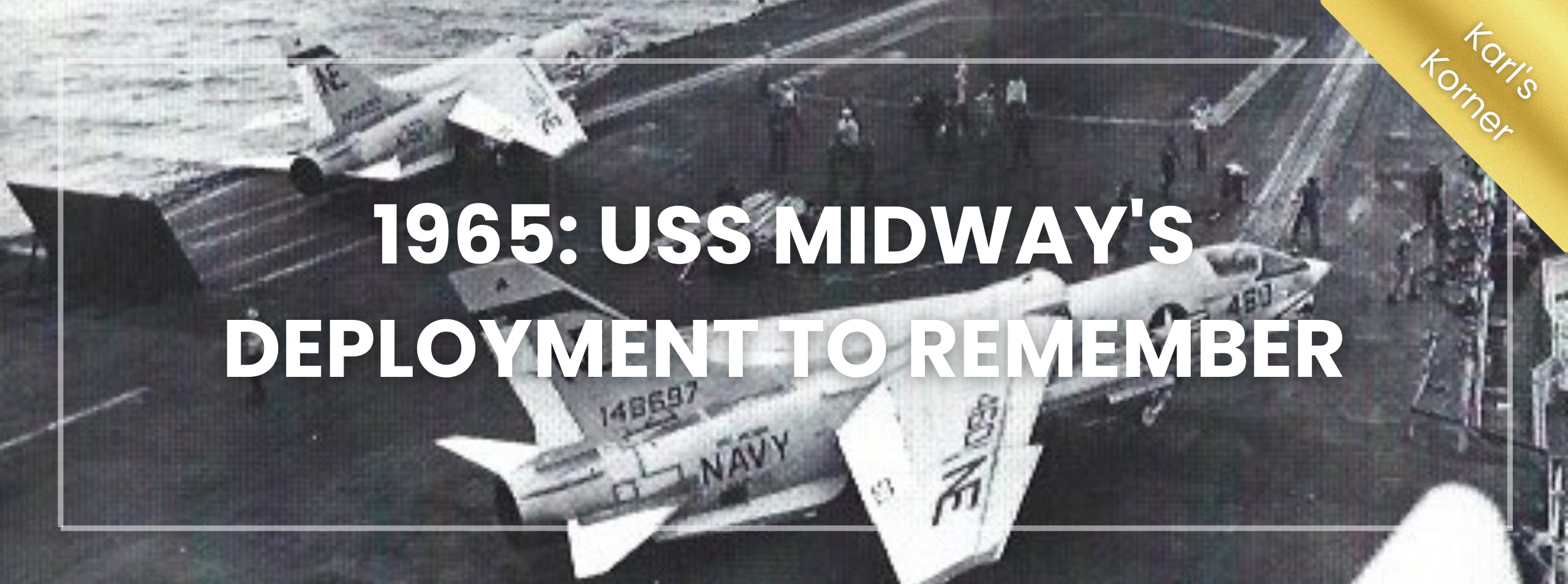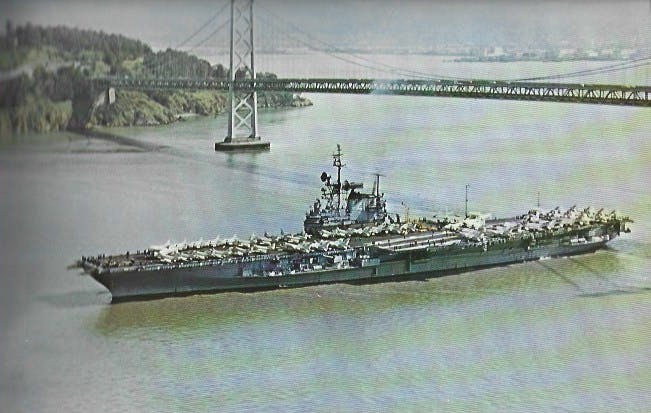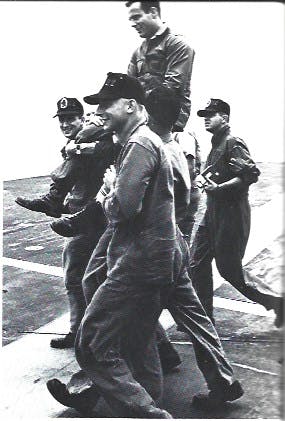 August 31, 2023 | Karl’s Korner
August 31, 2023 | Karl’s Korner1965: USS Midway’s Deployment to Remember
In March 1965, the USS Midway (CV-41) departed her Bay Area homeport of Naval Air Station Alameda for her first combat deployment. Though no strangers to waters off Southeast Asia, the carrier and her air wing were now returning to this troubled region during a shooting war. Operating about 100 miles off the South Vietnamese coast in the Tonkin Gulf at a spot called “Yankee Station,” Midway aircraft were tasked to conduct a sustained aerial bombardment of North Vietnam as part of Operation Rolling Thunder.

Intended more to exert political pressure on Hanoi’s ambitions than to inflict decisive damage, Rolling Thunder missions were carefully orchestrated from Washington and often neglected the tactical realities of the war and the experiences of the warfighters. While the campaign's deterrent objective ultimately failed, it certainly kept Midway’s aircrews busy during the deployment.
Arriving at Yankee Station in early April, the crew quickly fell into the routine of launching three strikes a day for seven days. Targets were typically enemy aircraft in flight, fuel storage tanks, barracks, bridges, barges, trains, and truck convoys. Although the bombardment had been going on for just over a month when Midway arrived, North Vietnamese defenses, provided mainly by the Soviet Union and China, were rapidly improving and becoming steadily lethal.
Ironically, Midway’s first aircraft loss was accidental. On April 20, Lt. Phillip Butler, an A-4 Skyhawk pilot with Attack Squadron 22 (VA-22), was forced to eject after the bombs he carried detonated immediately after being released from his aircraft. He managed to evade for four days before being captured. As a prisoner of war, Bulter helped disseminate the famous “tap code” for fellow prisoners to communicate from cell to cell secretly.
A double tragedy occurred the following month when Cmdr. James LaHaye, the commanding officer of Fighter Squadron 111 (VF-111), led a strike on the MiG air base near the North Vietnamese coastal city Vinh on May 8. Emerging from a cloud of bursting anti-aircraft shells, his F-8 Crusader was hit and streaming fuel. Turning towards the coast, his Crusader steadily lost altitude and crashed into the sea.
Squadron command passed to LaHaye’s executive officer, Cmdr. Doyle Lynn. Later that month, Lyn led in another strike mission over a target near Vihn. He too reported that he had been hit by enemy anti-aircraft fire and was lost when his Crusader crashed into the ground.
The remains of both LaHaye and Lynn have never been recovered.
Even specialized aircraft found it rough going in the campaign. On June 2, a rescue mission was called for a downed Attack Squadron 23 (VA-23) pilot. Providing close-in radar jamming for the rescue helicopter was an EA-1F Skyraider, an electronic countermeasures aircraft from Midway’s Carrier Airborne Early Warning Squadron 13 (VAW-13). The plane held a crew of four, including radio operator Petty Officer 3rd Class William Amspacher. Forced to fly along the North Vietnamese coast at low altitude, their mission brought them within range of enemy guns, and their aircraft was soon hit. Amspacher and the rest of the crew perished when the plane crashed into the beach. His remains were positively identified after they were returned to the United States by the Vietnamese government in 1988.
It was only a day later when Lt. Paul Ilg, also an A-4 Skyraider pilot with VA-22, was shot down over northeast Laos during a reconnaissance mission near the Ho Chi Minh Trail. The area’s remoteness worked to his advantage, as even the communist troops on the ground could not find him. Ilg spent two days successfully evading enemy forces before he was finally rescued by an Air America helicopter that was operated by the Central Intelligence Agency (CIA) conducting covert operations in Southeast Asia during the war.
History was made on June 17 when a flight of two F-4 Phantoms from Fighter Squadron 21 (VF-21) engaged four MiG-17s while supporting a strike mission south of Hanoi. Cmdr. Lou Paige and his wingman Lt. Cmdr. Bob Doremus, used their radar-guided Sparrow missiles to track and destroy two of the MiGs. With the Secretary of the Navy visiting aboard the Midway at the time, scotch flowed freely in the VF-21 ready room over the first MiG kills of the Vietnam War.

Three days later, a quartet of A-1H Skyraiders from Attack Squadron 25 (VA-25) supported another rescue when radar alerted them to two inbound MiG-17s. As the MiGs followed and rolled in slowly behind the lead Skyraider, Lt. Clint Johnson and his wingman, Lt. j.g. Charlie Hartman, slipped behind the MiGs. Both fired their 20mm cannons, sharing credit for downing one of the enemy fighters.
An unexpected adventure for Midway came on July 18 when the destroyer USS Frank Knox (DDR-742) ran aground on Pratas Reef halfway between Hong Kong and the Philippines. Midway was returning to Yankee Station after a port visit to Yokosuka, Japan, when she was diverted to the destroyer’s location, bringing the carrier within range of her SH-2 Seasprite helicopter detachment. With the Frank Knox firmly wrecked on the reef, a partial evacuation of the ship’s crew was ordered. In a series of shuttle flights, the diminutive SH-2 flown by Lt. Cmdr.Weslie Wetzel and Lt. j.g. Kent Vandervelde, along with aircrewman Petty Officer 1st ClassCharles Bowman, gingerly hovered over the destroyer’s small forecastle and transferred 155 Knox crew members to Midway. All three of the helicopter’s aircrew were awarded the Distinguished Flying Cross.
While it was confirmed that the Soviet Union was providing North Vietnamese advanced surface-to-air missiles (SAM), leaders in Washington prohibited strikes on these dangerous weapon systems for fear of harming Russian technicians. During a night reconnaissance on August 12 near Thanh Hoa, approximately 100 miles south of Hanoi, a pair of VA-23 A-4 Skyhawks flown by Lt. Cmdr. Frank Roberge and Lt. j.g. Donald Brown were above a cloud layer of 9,000 feet when they spotted what initially appeared to be a glow from aerial flares. However, the glow that was rapidly ascending through the cloud layer towards them was from the exhaust plume of an SA-2 SAM.
Although Roberge banked away violently, the detonation of the missile’s warhead damaged the Skyhawk, forcing him to nurse his aircraft back to Midway. Brown’s jet, unfortunately, was destroyed, taking him with it. Brown’s remains were positively identified in 1985.
This shootdown naturally enraged the naval aircrews on Yankee Station. More than 25 flight sorties were launched into the area where Brown went down in an attempt to find and destroy the SAM sites. With the low cloud cover persisting, VF-111’s Lt. j.g. Gene Gollahon flew his F-8 Crusader below the overcast in search of the SAM batteries. A ripe target, his plane was soon hit by anti-aircraft gunfire. His wingman saw that Gollahon’s cockpit canopy was missing as the crippled fighter tried to get back over water, but flames and explosions from the aircraft’s rear overtook the F-8, and it plummeted to the ground. Gollahon’s remains were returned to the United States in 1974.
VA-22’s Lt. j.g. Richard Brunhaver was pulling out of a bombing run on a bridge when his flight control column froze on Aug. 24. His A-4 Skyhawk struck the treetops and caught fire as it slowly climbed. Forced to be ejected, he was swiftly captured. Released from captivity in 1973, he spent more than seven years as a prisoner of war in Hanoi, where he endured harsh treatment.
End of the Deployment
After a nearly eight-month deployment, Midway returned home to Alameda on Nov. 23, two days before Thanksgiving. While on Yankee Station, Midway’s airmen conducted 11,900 sorties over North Vietnam, striking ground targets, shooting down four MiGs, and rescuing more than half of the Frank Knox crew.
However, a high price was paid during the deployment, with 17 aircraft lost to the enemy, resulting in the death of 11 aircrewmen and another five navy flyers spending several years incarcerated as prisoners of war. Regrettably, such losses became commonplace as the air war over Vietnam continued for nearly another eight years.
Midway entered Hunters Point Naval Shipyard in San Francisco shortly after her return from Vietnam for an extensive modernization that would take more than four years to complete. Returning to active status in 1970, and with fighting in Southeast Asia still raging, Midway and her crews would again return to the shores of Vietnam for multiple combat deployments before the war’s end in 1973.
Launch em’… until next time,
Karl
Your Adventure Starts Now
Your email is the key to information that will open up all your possibilities for exploring the mighty Midway!

